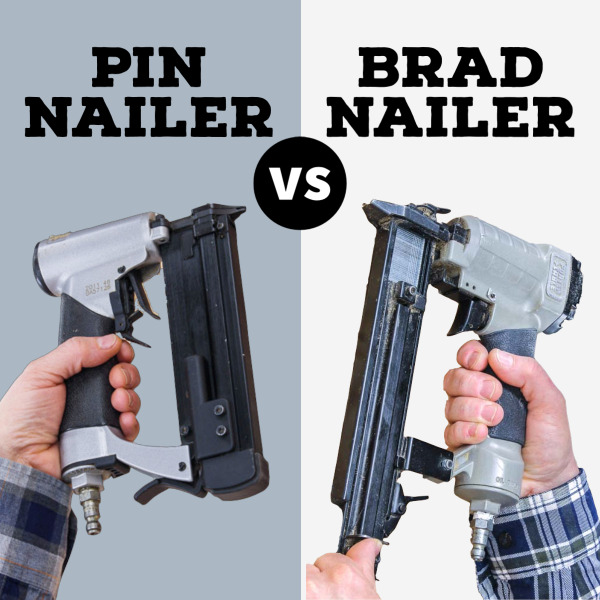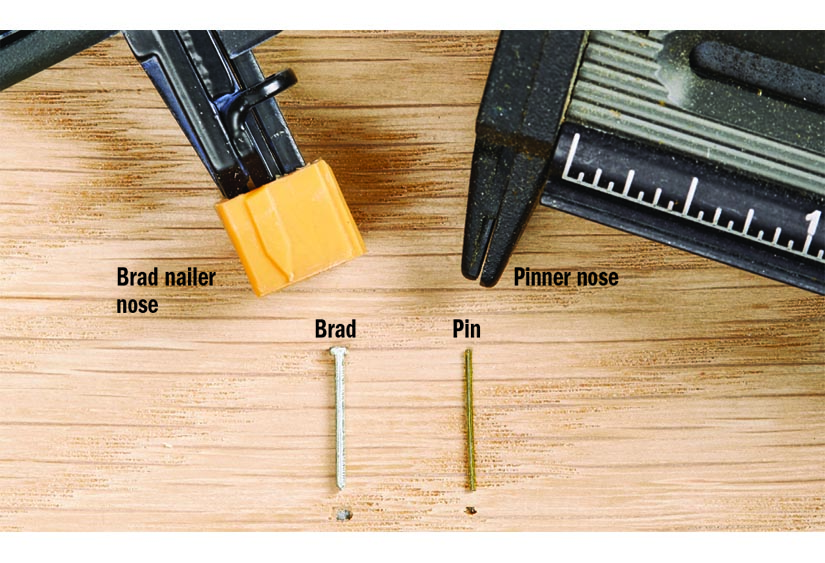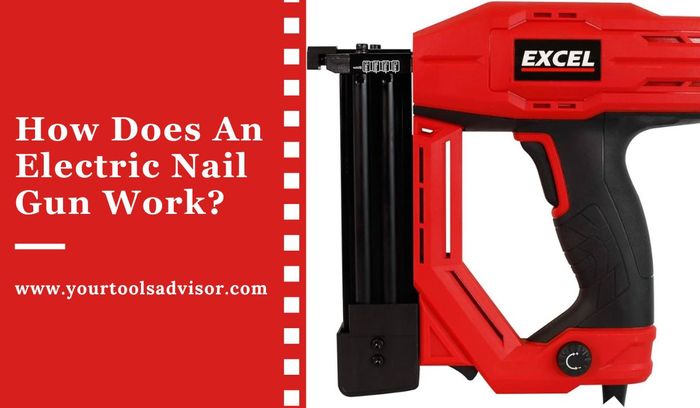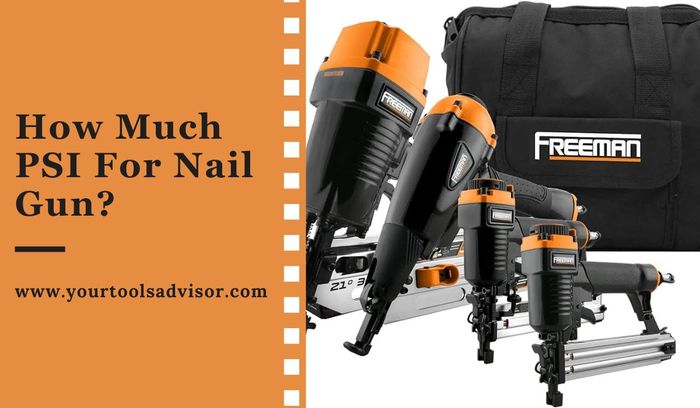The main difference between a pin nailer and a brad nailer is that a pin nailer is designed for small and delicate projects, while a brad nailer is used for heavier woodworking applications. Pin nailers are typically used for attaching lightweight trim, molding, and decorative pieces, as they leave barely visible holes and don’t require any touch-up work.
On the other hand, brad nailers are more versatile and can handle a wider range of tasks, such as cabinet assembly, furniture repair, and attaching baseboards. Both nailers use different sizes and lengths of nails, with pin nailers using extremely thin 23-gauge nails, and brad nailers using slightly thicker 18-gauge nails.
Understanding the differences and applications of these two tools can help you make the right choice for your specific project needs.
Pin Nailer Vs Brad Nailer: Understanding The Differences
A pin nailer is a type of nail gun specifically designed for precise, delicate, and minimal visibility nailing tasks. It uses headless pins that leave behind small holes that are barely noticeable, making it ideal for projects that require a high level of finish. Pin nailers are commonly used in woodworking projects such as attaching delicate trim, moldings, and small crafts. They can also be used for temporary hold of wood pieces during glue-up.
A brad nailer is a versatile tool used for fastening smaller and thinner materials like trim, molding, and paneling. It uses brad nails which have a small head and a slighter thicker gauge than pin nails. Brad nailers are suitable for tasks that require stronger holding power than what a pin nailer can provide. They are commonly used in woodworking, cabinetry, and construction projects where durability and strength are essential.
Pin nailers are primarily used for delicate and precise woodworking tasks, such as securing fragile trim and attaching small crafts, where maintaining a clean and virtually invisible finish is crucial. On the other hand, brad nailers are more versatile and can handle a wider range of applications. They are commonly used in woodworking, general construction, and even some upholstery projects.
Overall, understanding the differences between pin nailers and brad nailers is essential to selecting the right tool for your specific project needs. Consider the materials, finish requirements, and holding power required to make an informed decision and achieve the best results.
Pin Nailer Features And Benefits
When comparing pin nailers and brad nailers, one of the key factors to consider is the compact and lightweight design of pin nailers. These tools are typically smaller and lighter than brad nailers, making them easier to handle and maneuver during woodworking projects.
Another advantage of pin nailers is their accuracy in pin placement. With their thin and delicate pins, pin nailers allow for precise placement without causing any splitting or damage to the wood. This makes them ideal for tasks that require delicate and detailed work.
Additionally, pin nailers offer great versatility in woodworking projects. They can be used for a wide range of applications including trim work, delicate moldings, cabinet assembly, and other fine woodworking tasks. The pins used by pin nailers are typically small and leave almost invisible holes, reducing the need for extensive touch-up work after nailing.
Brad Nailer Features And Benefits
Brad nailers offer a range of features and benefits that make them a popular choice among DIY enthusiasts and professionals alike. One notable advantage is their larger nail capacity, which allows for longer nails to be used. This is especially beneficial when working on projects that require a stronger hold on materials, such as trim work and framing. The added length of the nails ensures a secure attachment, minimizing the risk of loosening over time. Additionally, brad nailers are ideal for precise and delicate tasks, thanks to their smaller size. They provide the necessary finesse to work on intricate projects, such as cabinet assembly and furniture repair. Overall, the versatility and precision of brad nailers make them a valuable tool in any woodworking arsenal.
Pin Nailer Vs Brad Nailer: Performance Comparison
When considering performance, it is important to look at the nail size and length. Both pin nailers and brad nailers have their own specific uses and compatible nail sizes. Pin nailers typically use 23-gauge pins, which are very thin and leave minimal holes. On the other hand, brad nailers commonly use 18-gauge brads, which are thicker and provide more holding power.
Holding power and strength are crucial factors to consider. Brad nailers have more holding power due to their larger size and thicker brads. They can effectively secure heavier materials and provide strong joints. Pin nailers, on the other hand, are perfect for delicate and lightweight projects where strong holding power is not necessary.
Precision and accuracy are key considerations when choosing between these two types of nailers. Pin nailers excel in precision, allowing for clean and nearly invisible fastening. They are ideal for delicate trim and moldings. Brad nailers offer good accuracy as well but are more visible due to the larger brads used.
Factors To Consider Before Choosing A Nailer
When considering which type of nailer to choose, there are several factors to take into account. First, evaluate your project requirements and scale. Pin nailers are ideal for delicate trim work and projects that require precise and discreet fastening. On the other hand, brad nailers are more versatile and can accommodate a wider range of materials and applications. Material compatibility is another important aspect to consider. Pin nailers are best suited for lightweight materials, while brad nailers can handle thicker and denser materials. Finally, take into account your personal skill and experience level. Pin nailers are easier to handle and require less force, making them suitable for beginners. Brad nailers, however, may be more challenging to control, requiring more experience and skill. By carefully assessing these factors, you can make an informed decision and choose the nailer that best suits your needs.

Credit: sawsonskates.com
Pros And Cons Of Pin Nailers
Pin nailers have several advantages which make them popular among professionals and DIY enthusiasts. Firstly, pin nailers are incredibly lightweight and compact, making them easy to maneuver and carry around. This makes them ideal for delicate trim work and detailed projects. Secondly, pin nailers produce tiny holes that are barely noticeable, eliminating the need for wood putty or touch-ups. They are also less likely to split delicate materials such as MDF or veneer. Additionally, pin nailers offer quick and easy nail removal, simplifying any repair or renovation work. However, it’s important to note that pin nailers have their limitations. They are not suitable for heavy-duty tasks and are not designed to provide a strong hold. Therefore, they are not recommended for applications that require robust bonding.
Advantages Of Pin Nailers
- Lightweight and compact design
- Minimal nail holes
- Less likely to split delicate materials
- Easy nail removal
Limitations Of Pin Nailers
- Not suitable for heavy-duty tasks
- Not designed for strong bonding
Pros And Cons Of Brad Nailers
Brad nailers are a popular choice among DIY enthusiasts and professionals alike. The advantages of brad nailers are numerous and make them a versatile tool for various projects. One of the key benefits is their size and design, as they are smaller and lighter compared to other nailers. This makes them ideal for delicate trim work or tasks that require precision. Brad nailers also leave smaller and less noticeable holes in the wood, reducing the need for putty or touch-ups. Additionally, their smaller size allows for improved maneuverability in tight spaces. However, it is important to consider the limitations of brad nailers. Due to their smaller size, they have a limited holding power and are not suitable for heavy-duty applications. They may also struggle with hardwoods or dense materials. Understanding these pros and cons will help you decide if brad nailers are the right choice for your project.
Pin Nailer Vs Brad Nailer: Key Takeaways
The main differences between a pin nailer and a brad nailer lie in their nail size and purpose. A pin nailer is perfect for delicate and precise woodworking projects, while a brad nailer is better suited for larger and sturdier materials.
Choose the one that suits your needs best.
- Factor in Your Specific Needs: When deciding between a pin nailer and a brad nailer, it is crucial to consider the specific needs of your projects. Pin nailers are best for delicate trim work, crafts, and lightweight moldings, as they leave minimal holes and are easily concealed. On the other hand, brad nailers are more versatile and can handle a wider range of applications, including crown molding, baseboards, and cabinets. They offer stronger holding power but may leave slightly larger holes. Consider the type of materials you work with, the size of nails required, and the specific tasks you need to accomplish when making your decision.
- Final Thoughts: Both pin nailers and brad nailers have their own advantages and are suitable for different projects. Understanding the differences and assessing your specific needs will ensure that you choose the correct nailer for your intended tasks. Remember to prioritize factors like hole size, nail holding power, and the type of projects you frequently undertake. With careful consideration, you’ll be able to select the right tool and achieve professional-looking results.
Frequently Asked Questions Of Pin Nailer Vs Brad Nailer
What Is A Pin Nailer Good For?
A pin nailer is used for fastening delicate or thin materials, such as molding or trim. It creates small, headless nails called pins, which leave behind minimal visible holes. The tool is ideal for precision work where a smaller and more discreet nail is desired.
Is A Pin Nailer Or Brad Nailer Better For Baseboards?
A brad nailer is better than a pin nailer for baseboards. It provides stronger and more secure attachment, ensuring your baseboards stay in place.
When Not To Use A Brad Nailer?
Avoid using a brad nailer when working with heavy-duty materials, such as hardwoods or metal. Additionally, refrain from using it for load-bearing tasks or projects that require significant structural support. The brad nailer is best suited for lightweight materials and delicate woodworking projects.
How Does A Pin Nailer Differ From A Brad Nailer?
A pin nailer is used for delicate projects that require small nails, while a brad nailer is better suited for larger, more heavy-duty tasks. Pin nailers leave smaller holes and are ideal for delicate trim work, while brad nailers are versatile and can handle a variety of projects.
Conclusion
To sum up, the choice between a pin nailer and a brad nailer ultimately depends on the specific needs of your woodworking projects. Both tools have their own advantages and limitations. While a pin nailer offers discreet and versatile fastening, a brad nailer provides sturdier and more secure connections.
Consider the materials, application, and desired finish to determine which nailer best suits your requirements. Make an informed choice and enjoy hassle-free and efficient woodworking!





Leave a Reply